The Other World Cup Woman to Watch
On a foggy Sunday morning in late November 2018, Paula Moltzan, then a sophomore at University of Vermont, stood at the top of Superstar at Killington. It was the last day of the Women’s World Cup. The horizon was a liquid gray. In the murky light it was hard to tell where snow ended and sky began.
It was the second time that Moltzan, a former Junior World Champion and NCAA champion, had faced this steep and gnarly World Cup slalom course. A year earlier, she’d stood in the same place, hoping to earn back her spot on the U.S. Ski Team, a position she had held for five years and abruptly lost after a poor season. Since her World Cup debut in 2012, Moltzan had competed in 17 World Cup events. She had only scored points (meaning a top 30 finish) in one.
That first year at Killington, in 2017, Moltzan had blasted out of the start on her first run. But her skis slid out as she arced around a gate. She went sliding down a slope that was as unforgiving as asphalt and crashed into the fencing.
Moltzan picked up the pieces. Bruised, she headed back to campus and went to class the next day. She wouldn’t be racing World Cup. Instead, she focused on her studies as a biology/chemistry major and trained with her Catamount teammates for the college circuit. At age 23, her chances of making it back on the team were few. But she was going to try.
When she came back to Killington a year later, in 2018, something was different. “I think I’d learned to take everything with a grain of salt,” she remembers. “I had gotten a taste of college life and knew that there was more to life than just ski racing.”
Though she had only five or six days on snow to train that season, Moltzan finished the first run in 28th. The top 30 racers would get a second run. “I was kinda shocked when I qualified and I knew I had to capitalize on that if I wanted to make ski racing my career,” she said. “It was either going to go really badly or really well.”
On the second run in uncharacteristically warm conditions that slushed up the course, Moltzan flashed through the gates. With the start order reversed, she was the third one on the course. When she looked up at the scoreboard at the finish her jaw dropped and she punched the air with her fist. Her time put her in first place for that run, a lead she held as skier after skier descended. She ended up with the fourth-fastest time for the second run, just 0.04 seconds off Mikaela Shiffrin’s lead. Her combined time put her in 17th overall, her career-best finish.
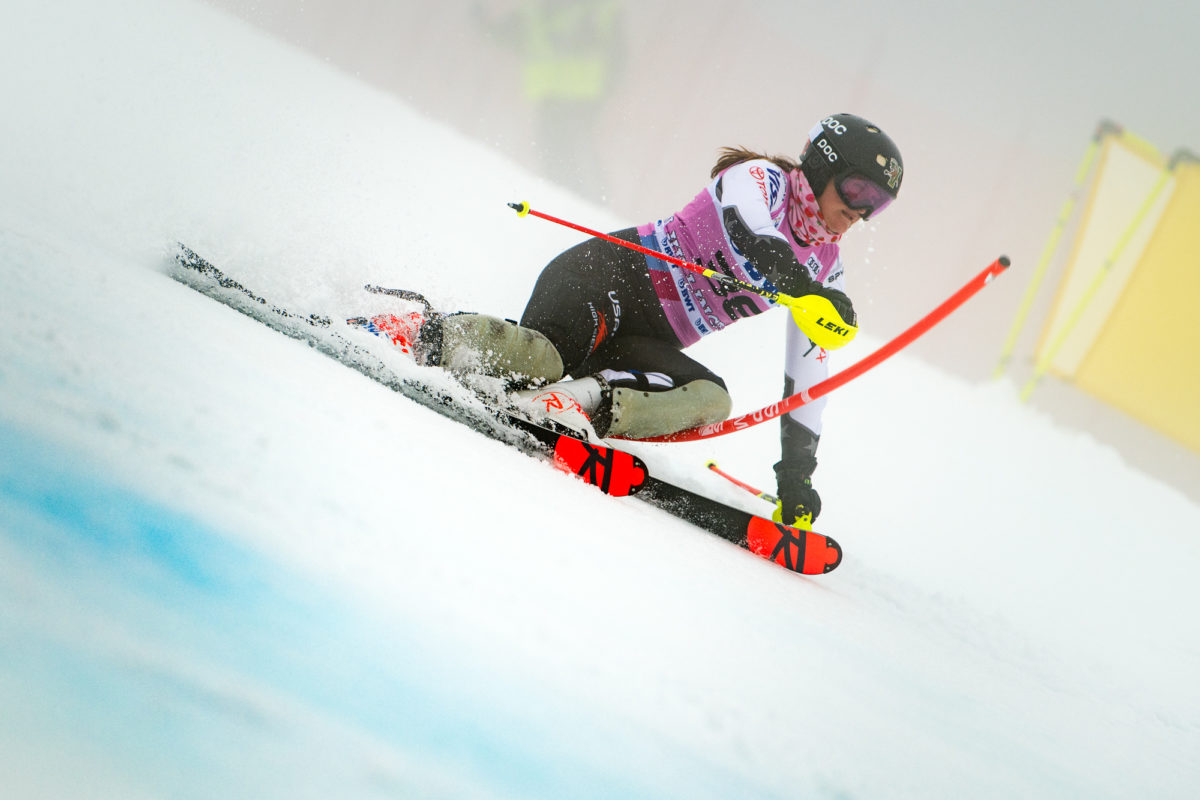
“I never really felt like I made it in ski racing until that day in Killington,” she said on the phone from Burlington this past fall, where she was visiting her sponsor, Skida. “After that, when I found out that I could start at some World Cups in Europe I figured I should find out what else was in the tank.”
What has happened since then is a remarkable story of how one woman defied the odds, proved age doesn’t matter as much as some might think and forged her own path to the World Cup, all while competing at the NCAA level and completing three years of college.
Now 27, Moltzan is the second-ranked slalom skier on the U.S. Team, just behind Mikaela Shiffrin, and moving up steadily. In 2021, she earned five top-10 World Cup finishes and her first World Cup podium.
So, what changed?
Small Hill, Big Dreams
Like former World Cup winners Lindsey Vonn and Kristina Koznick, Moltzan grew up skiing at Minnesota’s tiny Buck Hill where there are 262 feet of vertical drop.
“My parents were both ski instructors so I was on skis by the age of 2,” she says. “Ski school was like daycare for them, as they had to work weekends,” she recalled. At 5, she started training with the development team on weekends. At age 11, she joined the Buck Hill Ski Racing Team, started by legendary race coach Austrian Erich Sailer.
She earned her first FIS points in 2009, at the age of 15, and went on to earn silver in the giant slalom in the Junior Nationals that year.
Ski racing had become a top priority for the teenager. “I was in public school and my teachers started complaining that I was missing too many classes and something had to change,” she said. Her family began looking into ski academies.
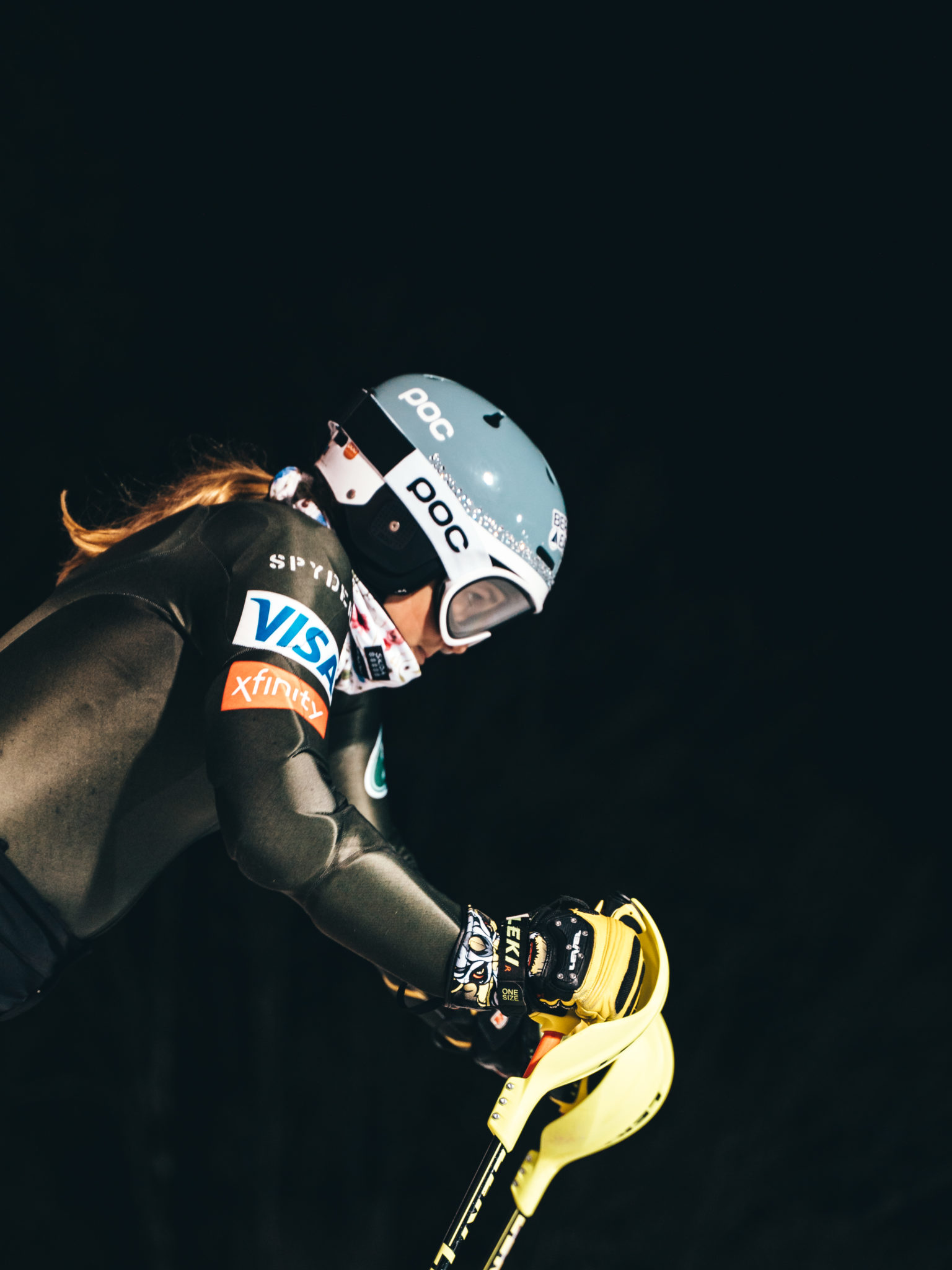 “We looked all over,” she remembered. “The Vail Ski & Snowboard Academy is part of the public school system there, so it made the most sense at the time to go there, plus they had a great coach, Dan Stripp.”
“We looked all over,” she remembered. “The Vail Ski & Snowboard Academy is part of the public school system there, so it made the most sense at the time to go there, plus they had a great coach, Dan Stripp.”
She enrolled for her junior year and by senior year, at 17, had made the U.S. Ski Team. In 2015, she became the first American woman to win the Junior World Championships in slalom and earned 20th in the World Championships. Over five years, she worked her way up from U.S. “D,” or development team, to the C team, then B team. She put off college to make ski racing her life.
Then came 2016. Of the seven World Cups she entered that season, only once did she make it into the top 30, the criteria for earning FIS points that would determine her ranking. That April, she got a call from Paul Kristofic, the women’s head coach. “PK told me I didn’t have the criteria to make the team. There wasn’t much I could say or do. I was pretty bummed,” she recalls. “Getting not renamed to the team is an emotional whirlwind. It’s someone telling you that you are not good enough. You go into shut down and denial.”
In spring of 2016, Moltzan found herself out of a job. At the time, the news was even harder to take as the criteria for someone her age, then 22, to make the U.S. Team was tougher for women than it was on men. To make the B team, a woman born between 1991 and 1996 (Moltzan was born in 1994) had to achieve a top-25 World Cup start list rank (based on World Cup points). For younger athletes, the criteria are a top 30 or top 45 rank, depending on year of birth. Men have two more years to reach those same criteria.
“We still have a long way to go toward equality in ski racing,” Moltzan told VT Ski + Ride in 2018 after the Killington World Cup. “Women have to perform better two years earlier than men do, which means there’s not a lot of room for women like me who want to ski race at the World Cup level and attend college.”
The Other Route
College: That hadn’t been something that Moltzan had planned on for that year. “It was April and I hadn’t applied anywhere and I wasn’t sure what I was going to do, but I was talking with Jimmy Cochran and next thing I knew I had a spot at UVM.” Cochran, the two-time Olympian, was assistant coach at UVM at the time. Moltzan was excited to work with him. UVM was also where her boyfriend, former Green Mountain Valley School racer, Ryan Mooney, was planning to go.
She started classes that fall. Though Cochran soon left UVM to help run the family ski area in Richmond, his cousin Tim Kelley, himself a former World Cup racer, stepped in as a coach. “Tim really got me and knew what I needed,” Moltzan said at the time.
Bill Reichelt, the head coach at UVM for the past 20 years, watched her progress. “Paula would give it her all and then crash hard, but she’s rugged,” Reichelt recalls. “I remember watching her train on Main Street in Stowe and go flying off the hill into the woods. I saw Ryan, her boyfriend, waving his arms and I started to run up to her, reaching for my tourniquet. These days, with the skis so sharp, we all carry tourniquets and my first fear was that she was cut.”
She wasn’t and picked herself up again and got back on the next lift up. “She would do that. Other people might call it a day after a crash like that, but Paula would keep training,” says Reichelt.
What changed that year, though, was that Moltzan was now part of a team. In NCAA racing, a school’s win is based on how the team as a whole does – both Nordic and alpine. “It wasn’t just about my performance it was about how the 12 members of the team did. I didn’t have to win every race, but I did have to finish,” she remembers.
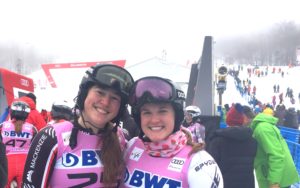
“I think what college racing did for Paula was it taught her to operate her governor,” Reichelt says. She began to ski less recklessly. And at the end of her freshman season, she won the race she still says she is most proud of: the NCAAs at Cannon Mountain, N.H..
While at UVM, Moltzan also got to watch her fellow Catamount and friend Laurence St. Germain compete on the World Cup for Canada. With renewed confidence, Moltzan had the itch to get back into international competition.
In the fall of 2017, she sent a letter to the U.S. Ski Team asking if she could compete in a time trial in Colorado – her only chance to earn herself a starting position at Killington’s World Cup that Thanksgiving weekend. Moltzan won the time trial.
All she had to after that was finish in the top 30 to earn herself a chance to continue to compete on the circuit. But that didn’t happen…yet.
The Killington Breakthrough
Moltzan was back at the World Cup in Killington in 2018, this time with the mantra of “finish, just finish.” “I think being in college taught me that there was more to life than just ski racing,” she said. “I was training less than I ever have, but just having more fun skiing and the pressure was off.”
Shiffrin, as predicted, won the race, but Moltzan ended up 17th, just three places behind her UVM teammate Laurence St. Germain and five places ahead of U.S Ski Team’s Nina O’Brien. It was her best finish ever and she was ecstatic.
That finish secured Moltzan the opportunity to start in other World Cups. The challenge was she would have to do so on her own, without U.S. Ski Team support. “Fortunately, a lot of the events were happening at the same time I was off from college for the holidays,” Moltzan said. Mooney, signed on as her official ski tech. They raised about $15,000 and headed to Europe as a ski racing team of two.
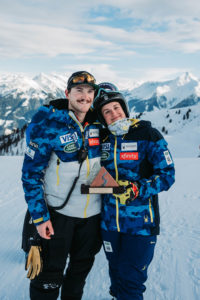 While the national teams had coaches, trainers, physical therapists, containers of skis to choose from and organized practices, Moltzan and Mooney had to finagle their way as a two-person squad. The U.S. Team helped out where they could. “Paula was good friends with some of the Swedes, and they let us train with them a few times,” Mooney recalls.
While the national teams had coaches, trainers, physical therapists, containers of skis to choose from and organized practices, Moltzan and Mooney had to finagle their way as a two-person squad. The U.S. Team helped out where they could. “Paula was good friends with some of the Swedes, and they let us train with them a few times,” Mooney recalls.
Her first race was a World Cup in Courchevel, France on Dec. 22, 2018. There, she finished 15th – a career best. Then it was on to Croatia and then to Flachau, Austria where she finished 12th.
Something was clicking.
For the rest of January and February, Moltzan traveled back and forth between New England, where she was still competing for UVM on the NCAA circuit, and the World Cup, where she scored a 16th in Slovenia in slalom and then an 18th in Are, Sweden in the World Championships. In between, she was studying for her major in biochemistry and keeping up a 3.8 grade point average.
“I think one thing that helped is I was actually skiing less but managing my time better,” Moltzan recalls. That often meant arranging a course schedule around six days of training a week during the season, getting to Stowe by 7:30 a.m. for three-hour practice sessions, and traveling on weekends for races.
“There are not many ski racers who can compete at the World Cup level while going to college,” notes Reichelt. UVM teammate Laurence St. Germain ended up taking time off while racing for Canada and competing at the PyeongChang Olympics. For U.S. Ski Team racers like Nina O’Brien and A.J. Hurt, Dartmouth’s summer semester has. allowed them to take winters off. Moltzan completed her junior year and then, in 2019/20 as she rejoined the team and aged out of NCAA eligibility, decided to take time off.
Traveling with her this whole time was Mooney. Mooney had grown up in a family of whitewater paddlers, who operate Crab Apple Whitewater, a rafting company in Charlemont, Mass. He attended Green Mountain Valley School in Waitsfield, Vt. on a scholarship.
“Like all scholarship students, I had to work while I was there, so I tuned skis,” he says. “When Paula was on the U.S. Team, she always had someone else do it for her—I’m not even sure she knew how,” he says with a laugh. “It just made sense that I would tune them for her, and I liked to do it,” he says.
The two first met in 2012 at a summer training camp in Valle Nevado, Chile. Mooney was 16 at the time, Paula was 18. “She was one of the hot U.S. Ski Team girls,” he remembers. . They hung out as friends at first, then ran into each other at another camp in Colorado and things progressed. When Moltzan started at UVM, Mooney was there too, already a sophomore. In the fall of 2020, the two went for a walk on the Burlington waterfront, and Mooney proposed.
After Moltzan’s stellar season as a solo racer, she earned a spot back on the U.S. B Team. She took time off from school (at 26, she was no longer eligible to compete in the NCAAs circuit) and Mooney followed as her ski tech and photographer, shooting her racing, goofing off with her friends and fellow teammates A.J. Hurt and Nina O’Brien, and taking side trips together to see parts of Europe when they could.
The 2020/21 season turned out to be Moltzan’s best yet, starting with a 10th in giant slalom in Soelden, Austria. At the parallel World Cup in Lech she had made it to finals and was neck and neck with Slovakia’s Petra Vhlova, the world champion in giant slalom, with just three gates to go when Moltzan crashed.
But she already had her silver in hand and the knowledge that to get there she had beaten some of ski racing’s best: Switzerland’s Lara Gut-Behrami and Italy’s Marta Bassino. Moltzan also managed to win the Italian National Championships and place fourth in the World Championships in parallel slalom that season.
“I’m competitive,” Moltzan admits. Getting on the course with another skier gets her juices flowing. In the 2022 Beijing Olympics, Moltzan will be a contend in the parallel slalom, as well as the slalom.
Though Covid cut the season short and both she and Mooney contracted the virus, she still managed to finish the 2020/21 season ranked 11th overall in slalom, the second highest ranked American slalom racer after Mikaela Shiffrin. In June 2021, for the first time, she was named to the U.S. Ski Team’s A-Team.
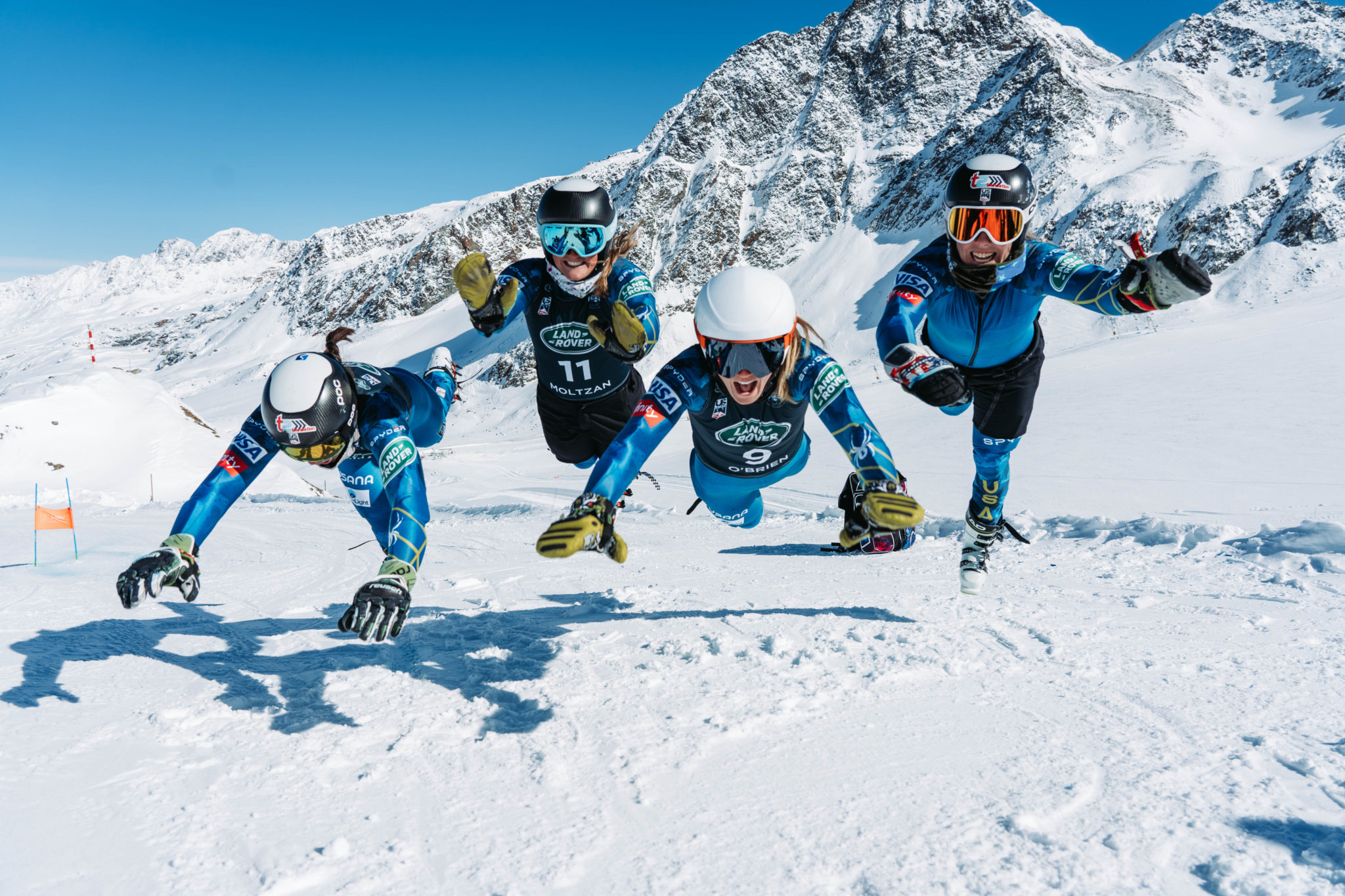
Life on the A Team
On the U.S. Ski Team’s A-Team. Three-quarters of her way through college. Engaged. Paula Moltzan has already ticked off some big boxes. Still, this summer saw her training harder than ever. “We set up this gym in this former woodshed on the Mooney’s property,” Moltzan says. There she would do the workouts sent her by her U.S. Ski Team coaches using second-hand weights.
“Paula is so tough it’s hard to keep up with her,” says Ryan. “She will do these 3-hour runs up and down mountain bike trails near us and if she gets done early, she’ll just keep running in place until she hits exactly three hours,” Mooney says.
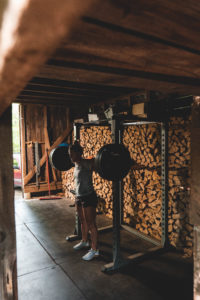 In between workouts both she and Ryan worked as river guides taking clients down the rapids on the Deerfield. Negotiating whitewater, says Mooney, is a bit like navigating slalom gates. “You’re always focused on the next move, sort of looking ahead, flowing down the river and around the rocks.”
In between workouts both she and Ryan worked as river guides taking clients down the rapids on the Deerfield. Negotiating whitewater, says Mooney, is a bit like navigating slalom gates. “You’re always focused on the next move, sort of looking ahead, flowing down the river and around the rocks.”
This November when Moltzan once again stands in the World Cup starting gate at Killington, things will again be different. Her ranking will earn her a higher start position, no longer in the back of the pack skiing in others’ ruts. Her spot on the A-Team has earned her more support – both in terms of access to the training and technology the U.S. Ski Team dedicates to its A-players, but also financial support. Her sponsors now include Rossignol, POC, Leki, Aqua Vitae and Skida.
And she will have the support of two extended families—including grandparents and siblings and cousins—watching from the grandstands. “All of my family and all of Ryan’s family will be there. That’s huge; they are the ones who have been so supportive,” she says. They will be cheering for what has become known in her circles as #ThePaulaProject.
After that? More World Cup races, very possibly the Olympics in Beijing and, next September, a wedding near the Mooney’s home in Charlemont. Then house hunting in Vermont.
“I’m definitely finishing my last year of college at UVM,” she says.
But first, she has some unfinished business on skis. n

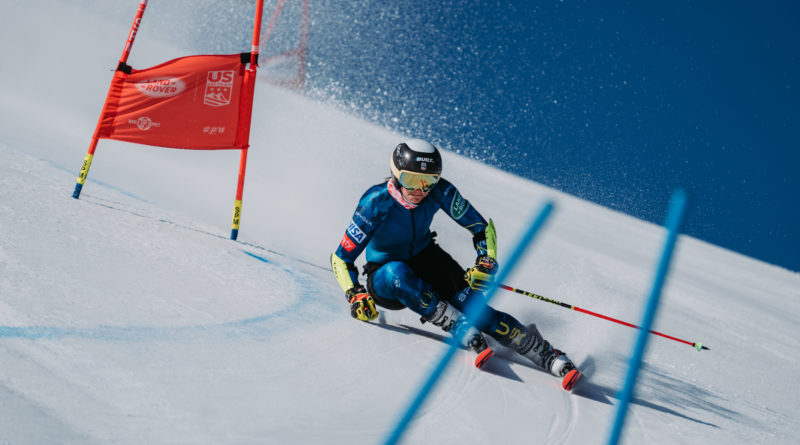
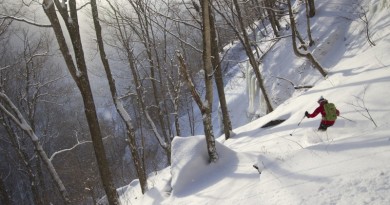
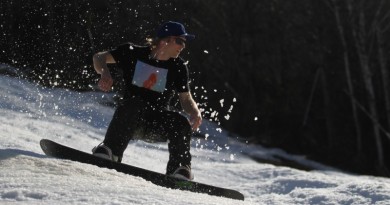
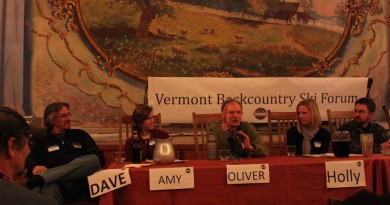
Pingback: Two U.S. Women, Trained in Vermont, Fly on First Slalom Run – VT SKI + RIDE